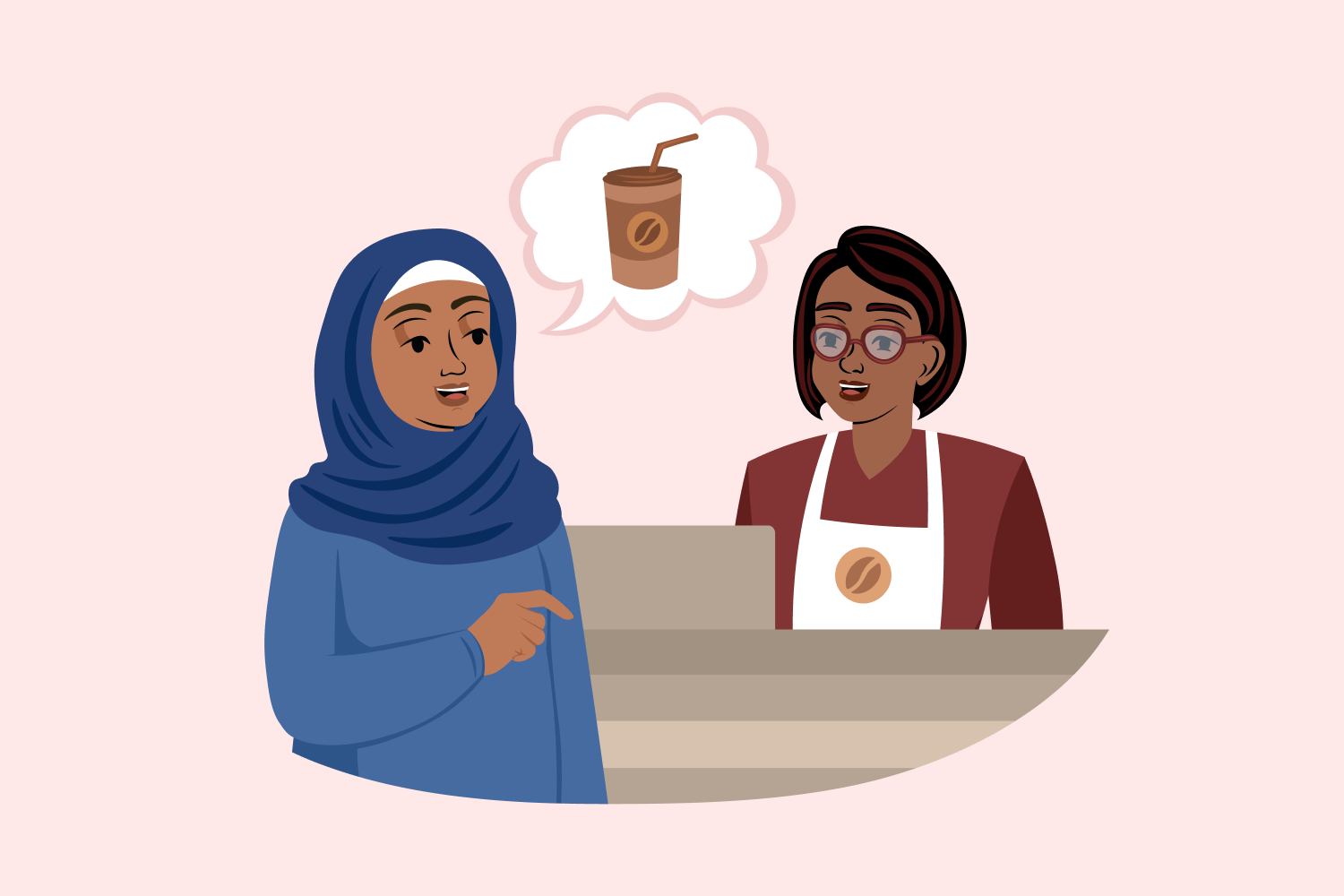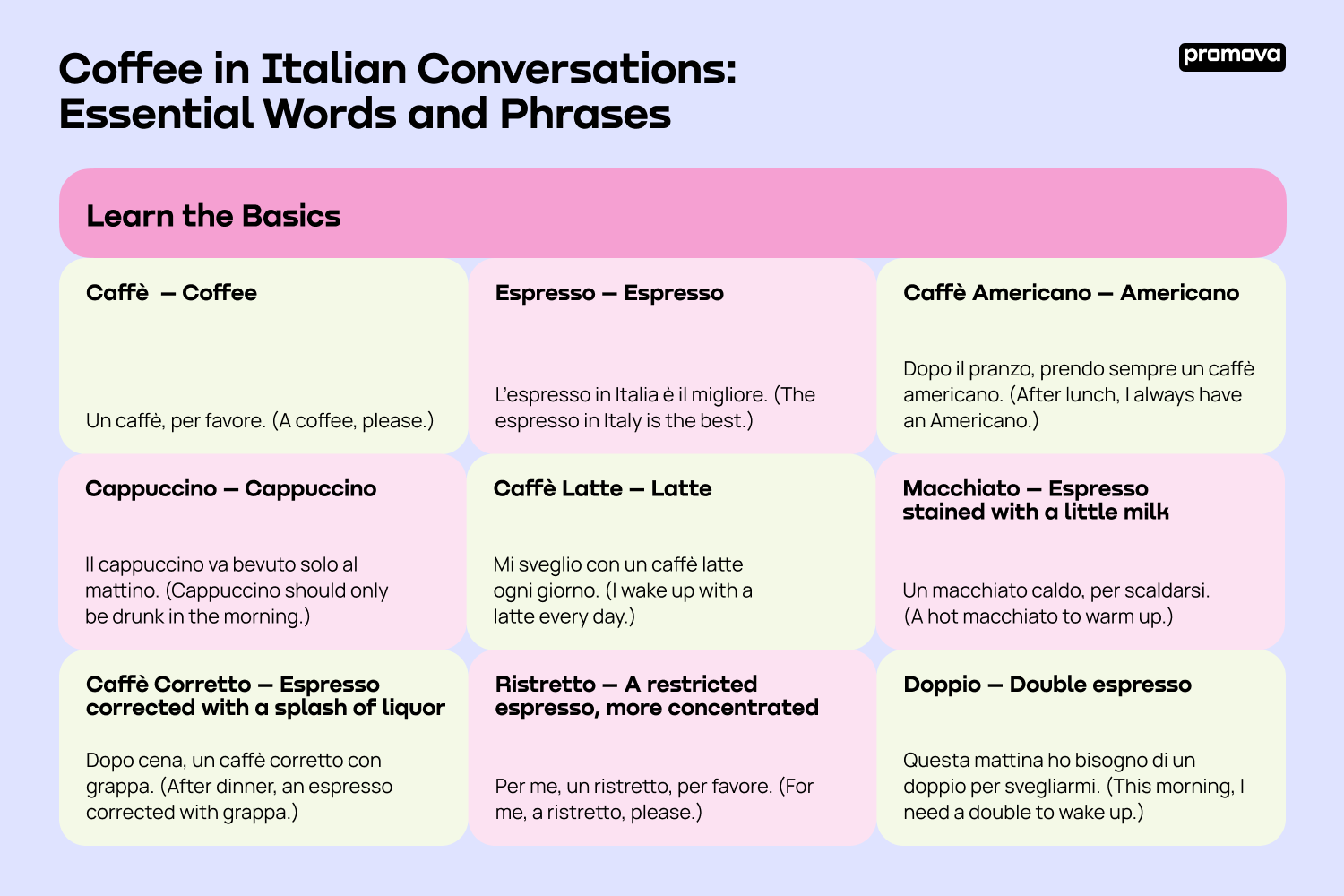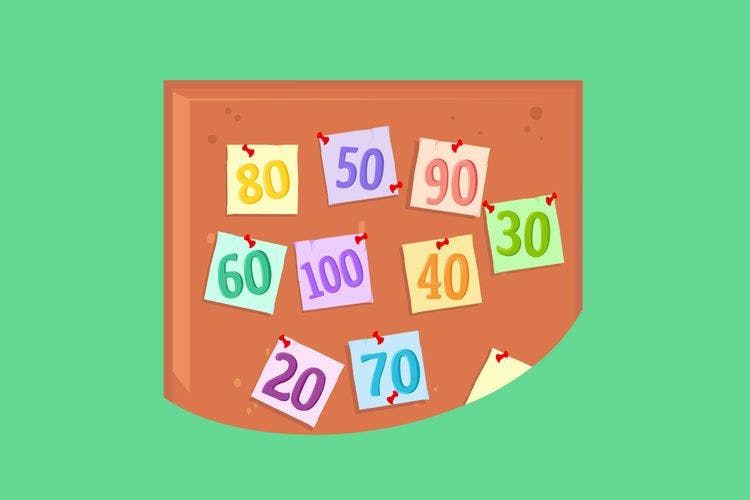Coffee in Italian Conversations: Essential Words and Phrases

Contents
In Italy, you breathe coffee as much as air: it fuels conversations, seals deals, and ties every meal. You hear the cup's clink, the spoon's stir, the espresso machine's gentle hiss. Knowing how to order coffee in Italian is crucial because it is a fundamental part of daily life. With our comprehensive guide, you’ll master the necessary words, phrases, and etiquette. Equipped with this, you will sit in any bar and order coffee like a true Italian.
Italian Words for Coffee: Learn the Basics
In Italy, coffee is more than a beverage; it’s a cultural cornerstone that shapes social events and the daily routines of millions of people. It is always present whether you’re at a bar, a restaurant, or a meeting. Knowing how to say coffee in Italian and other related words is always useful. Let’s start with the basics:
- Caffè [kafˈfɛ] – Coffee
Un caffè, per favore. (A coffee, please.)
- Espresso [esˈprɛsso] – Espresso
L’espresso in Italia è il migliore. (The espresso in Italy is the best.)
- Caffè Americano [kafˈfɛ ameriˈkano] – Americano
Dopo il pranzo, prendo sempre un caffè americano. (After lunch, I always have an Americano.)
- Cappuccino [kapputˈtʃiːno] – Cappuccino
Il cappuccino va bevuto solo al mattino. (Cappuccino should only be drunk in the morning.)
- Caffè Latte [kafˈfɛ ˈlatte] – Latte
Mi sveglio con un caffè latte ogni giorno. (I wake up with a latte every day.)
- Macchiato [makˈkjaːto] – Espresso stained with a little milk
Un macchiato caldo, per scaldarsi. (A hot macchiato to warm up.)
- Caffè Corretto [kafˈfɛ korˈretto] – Espresso corrected with a splash of liquor
Dopo cena, un caffè corretto con grappa. (After dinner, an espresso corrected with grappa.)
- Ristretto [risˈtretto] – A restricted espresso, more concentrated
Per me, un ristretto, per favore. (For me, a ristretto, please.)
- Doppio [ˈdoppjo] – Double espresso
Questa mattina ho bisogno di un doppio per svegliarmi. (This morning, I need a double to wake up.)

We covered the basic Italian coffee vocabulary. These words are common in cafés and day-to-day conversations. Next time you visit Italy, use them to get the perfect cup of coffee.
1
How to Order Coffee in Italian: Your Go-to Phrases
Let’s now review some key Italian phrases to ensure a smooth experience when discussing or ordering coffee. With these expressions, you will feel confident during your outings to local cafés:
- Posso avere un caffè? [ˈposso aˈvere un kafˈfɛ] – Can I have a coffee?
This is a straightforward question: Can I have a coffee in Italian? It’s polite and to the point, making it perfect for beginners.
Buongiorno, posso avere un espresso e un cornetto, per favore? (Good morning, can I have an espresso and a croissant, please?)
- Quanto costa? [ˈkwanto ˈkɔsta] – How much does it cost?
After ordering, you might want to know the price. This phrase helps you ask for the cost of your coffee or any other item.
Quanto costa un cappuccino e un panino, per favore? (How much does a cappuccino and a sandwich cost, please?)
- Posso sedermi qui? [ˈposso seˈdermi ˈkwi] – Can I sit here?
If you’re at a busy café and spot a free seat, use this phrase to ask if it’s taken. It’s a polite way to ensure you’re not taking someone’s spot.
Scusi, posso sedermi qui o è occupato? (Excuse me, can I sit here or is it taken?)
- Un caffè da portar via, per favore. [un kafˈfɛ da porˈtar vja, per faˈvore] – A coffee to go, please.
If you’re in a hurry, this phrase lets you order a drink to take away. It’s useful for those busy mornings when you need your coffee on the run.
Sono in ritardo, posso avere un caffè da portar via, per favore? (I’m running late, can I have a coffee to go, please?)
- Vuoi un caffè? [ˈvwɔi un kafˈfɛ] – Do you want coffee?
When you’re in company, you can use the phrase Do you want coffee in Italian. It’s a kind gesture, demonstrating hospitality and care.
Vuoi un caffè o preferisci un tè? (Do you want a coffee, or would you prefer tea?)
- Che tipo di caffè avete? [ke ˈtipo di kafˈfɛ aˈvete] – What kind of coffee do you have?
When confronted with multiple coffee options, you can use this phrase to inquire about the varieties available. It will allow the barista to provide details or suggest a choice.
Che tipo di caffè avete? Sono abituato al caffè americano. (What kind of coffee do you have? I am used to American coffee.)
- Senza zucchero, per favore. [ˈsɛntsa ˈdzukkero, per faˈvore] – Without sugar, please.
This phrase comes in handy when you prefer your coffee without any sweetener. Inform the barista that you’d like your drink without sugar to ensure they prepare it as you want.
Senza zucchero, per favore. Il mio caffè, non mi piace dolce. (Without sugar, please. I don’t like my coffee sweet.)
- Fate caffè d’orzo qui? [ˈfate kafˈfɛ dˈɔrtso kwi] – Do you make barley coffee here?
It is how you ask if a café serves barley coffee, a popular caffeine-free alternative in Italy. If you want to try something different, don’t hesitate to use this phrase.
Fate un buon caffè d’orzo in questo bar? (Do you make good barley coffee in this bar?)
Understanding how to order espresso in Italy guarantees a superior coffee experience. Remember, Italian baristas take great pride in their craft. So, be clear, use the proper terminology, and be kind. The reward will be a perfect cup of coffee every time – all thanks to some simple yet effective Italian phrases.
Drinking Coffee in Italian Bars: Etiquette and Tips
Italian coffee bars offer a totally different atmosphere based on their own set of written and unwritten rules. The local etiquette will help you enjoy the full experience. Here are some key tips to note when navigating the coffee culture:
- Stand at the bar. Many Italians enjoy their espresso standing at the bar. It’s quick, less expensive, and offers a chance to chat with the barista or locals.
- Know your order. Italian coffee menus can be extensive. Before you reach the counter, decide whether you want an espresso, cappuccino, latte, or something else. Remember, milk-based coffees are typically a morning affair.
- Pay first, then order. At many bars, you pay at the cashier before ordering your coffee at the counter. You’ll receive a receipt to show the barista.
- Savor the moment. Even though drinking coffee can be a quick activity, Italians value the quality of their drinks. Take a moment to enjoy its aroma and flavor.
- Avoid milk in the afternoon. Ordering a cappuccino after 11 a.m. is often frowned upon by locals. After breakfast hours, switch to espresso or a macchiato for an authentic experience.
- Use polite forms. When ordering, use per favore [pɛr faˈvoːre] (please) and grazie [ˈɡrat.t͡sje] (thank you). Politeness is key in Italian culture, even in the informal setting of a bar.
- Leave a tip. While tipping isn’t as customary in Italy as in other countries, leaving a few coins at the bar as a tip is appreciated if you like the service.
By applying these simple rules, you can enjoy an Italian coffee in its true authenticity. From a crowded bar in Milan to a small café in Florence, these principles will allow you to appreciate the culture in a better way.
Promova: Your One-Stop Solution for Language Learning
Discover the magic of language learning with Promova, a one-stop solution that covers everything from English and Italian to Chinese and Korean. With an array of guided courses, personal 1x1 English lessons, and group sessions, there is something for everyone, regardless of their skill level.
Our guided courses equip you with all the tools for successful language learning. They are available in our mobile app and on our website and offer comprehensive modules tailored for all proficiency levels, from vocabulary to grammar. Frequent tests and interactive quizzes provide opportunities for self-assessment throughout your journey.
We provide 1x1 English tutoring for those who seek personalized attention. Our expert teachers focus on your unique learning needs and pace. The first lesson is free, so you can assess our teaching style and decide if it aligns with your goals.
Should collaborative study appeal to you, participation in our group sessions is possible. Such lessons offer a unique space, enabling English practice with other students. You can share ideas, discuss topics, and learn from each other in a relaxed, friendly environment.
Join the Conversation Club if you want to polish your English speaking abilities. This weekly event allows for engaging dialogues with fellow language enthusiasts. The best part? The Conversation Club is completely free of charge!
Conclusion
Italian coffee culture is a world of its own. Knowing the flavors, words, and proper etiquette goes beyond ordering coffee in Italy – it’s about integrating this important part of Italian culture into your lifestyle. Armed with the knowledge from this guide, you can confidently walk into the café or bar and join the country’s tradition. Immerse yourself, explore the rich selection of beverages, and adopt the Italian way of coffee drinking.
FAQ
How do Italian bars differ from American or British bars?
Italian bars are community hubs that offer everything from coffee to alcohol. They differ from their American or British counterparts, which prioritize alcoholic beverages. Throughout the day, they meet a range of customer requirements – in the morning, they serve espresso and pastries, and in the evening, apéritifs. These places usually foster a relaxed and welcoming atmosphere for all ages.
What’s the best way to learn Italian coffee culture vocabulary?
Watch videos and blogs from native Italians who share their experiences of coffee making and the meanings of each drink. Italian cooking and travel shows frequently feature the coffee culture, which offers a visual and auditory learning experience.
How does ordering coffee in Italy help with language practice?
Saying I would like a coffee in Italian allows you to practice the language daily using specific phrases and vocabulary. It also puts you in a position to listen to native speakers, see cultural customs, and engage in actual life situations. These events are a perfect way to boost your confidence in speaking skills.
How can I immerse myself in the Italian culture deeper?
Online sites like Italy Magazine Community or The Local Italy can offer a platform to interact with locals and expats living in the country. They share experiences, tips, and insights to help you better understand Italian culture. For learning the tongue, the Italian language learning app by Promova is a great tool. It provides a range of effective, engaging lessons for students at all levels.



Comments